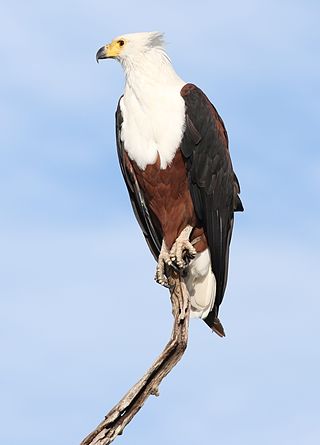
The African fish eagle or the African sea eagle is a large species of eagle found throughout sub-Saharan Africa wherever large bodies of open water with an abundant food supply occur. It is the national bird of Malawi, Namibia, Zambia, and Zimbabwe. As a result of its large range, it is known in many languages. Examples of names include: Vis Arend in Afrikaans, nkwazi in Chewa, aigle pêcheur in French, hungwe in Shona, inkwazi in isiZulu, and ntšhu in Northern Sotho. This species may resemble the bald eagle in appearance; though related, the two species occur on different continents, with the bald eagle being resident in North America.

The flathead grey mullet is an important food fish species in the mullet family Mugilidae. It is found in coastal temperate, tropical and subtropical waters worldwide. Its length is typically 30 to 75 centimetres. It is known with numerous English names, including the flathead mullet, striped mullet, black mullet, bully mullet, common mullet, grey mullet, sea mullet and mullet, among others.
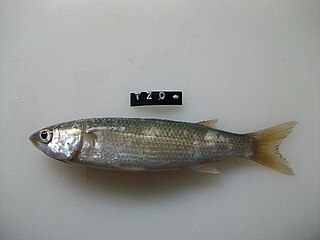
The South African mullet, also called a harder mullet or simply harder, is a species of mullet. It is found in South African coastal waters from Walvis Bay (Namibia) to KwaZulu-Natal, and grows to a maximum length of 40.5 cm (15.9 in). The person the specific name honours was not recorded by Andrew Smith when he described this species but it is most likely to be John Richardson (1787-1865), the Scottish naturalist, surgeon and Arctic explorer.
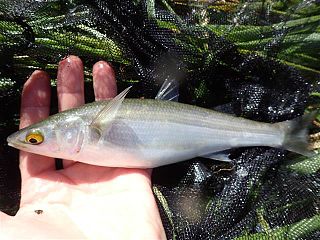
Yellow-eye mullet, also known as Coorong mullet, conmuri, estuary mullet, Forster's mullet, freshwater mullet, pilch, pilchard, Victor Harbor mullet, yelloweye and yellow-eyed mullet, are small, near-shore fish found in temperate waters of southern Australia from just north of Sydney, New South Wales to Shark Bay in Western Australia, around Tasmania, and New Zealand.

The white mullet or silver mullet is a tropical and subtropical marine fish of the family Mugilidae. It is commonly about 30 cm (12 in) long.
Chelon is a genus of mullets found in coastal marine waters, estuaries and rivers in the Atlantic Ocean and Arabian Sea.
The Otomebora mullet, the giantscale mullet or St. Lucia mullet, is a species of ray-finned fish in the family Mugilidae. It is found in the Indo-Pacific Region.
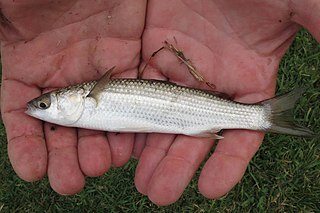
The freshwater mullet is a species of ray-finned fish in the family Mugilidae. It is endemic to South Africa.

Eleutheronema tetradactylum, the fourfinger threadfin, known as ranwas in India is a species of marine ray-finned fish, a threadfin from the family Polynemidae which occurs in the Indian and western Pacific Ocean.

The black bream, also commonly known as the southern black bream, southern bream and blue-nosed bream, is a species of anadromous ray-finned fish of the porgy family Sparidae. A deep-bodied fish, it is occasionally confused with other similar species that occur within its range, but is generally distinguished from these species by a lack of yellow ventral and anal fins. Southern black bream are endemic to the southern coasts of Australia from Shark Bay in Western Australia to Ulladulla, New South Wales, as well as Tasmania.

Wilson Inlet is a shallow, seasonally open estuary located on the coast of the Great Southern region of Western Australia.

The so-iuy mullet, also known as the haarder, redlip mullet or so-iny mullet, is a species of ray-finned fish in the family Mugilidae.

The largescale mullet is a species of ray-finned fish in the family Mugilidae. It is found in the Indo-Pacific.
The Blyth River is a river in the Northern Territory, Australia.

Planiliza parsia, the goldspot mullet, is a species of ray-finned fish in the family Mugilidae. It is one of 15 species in the genus Planiliza. This species is found in the Indian Ocean in shallow coastal waters of Pakistan, India, Sri Lanka and the Andaman Islands. It also lives in lagoons, estuaries, and tidal rivers.
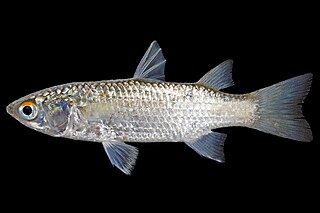
Planiliza is a genus of mullets found in coastal marine waters, estuaries and rivers in the Indo-Pacific.

The squaretail mullet, also known as the diamondscale mullet, is a species of grey mullet from the family Mugilidae. It is an Indo-Pacific species and is the only species in the monospecific genus Ellochelon.
The Diassanga mullet is a species of ray-finned fish, grey mullet from the family Mugilidae. It is found in the eastern Atlantic around the coasts of West Africa.

The grooved mullet is a species of ray-finned fish, a grey mullet from the family Mugilidae. It is found in the coastal waters of the eastern Atlantic Ocean off the western coast of Africa, as far north as Mauritania, and into the western Indian Ocean.
The pinkeye mullet, also known simply as pinkeye, or freshwater mullet, Richmond mullet, or river mullet, is a species of ray-finned fish from the grey mullet family Mugilidae and the only species in the genus Trachystoma. It is endemic to northeastern Australia where it occurs from the Burnett River in Queensland to the Clyde River in New South Wales. It is a subtropical species which is found in deep, slow flowing sections of rivers as well as in estuaries although it moves into coastal seas to spawn. It feeds mainly on algae and plant material, as well as detritus and benthic invertebrates.















